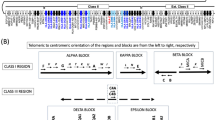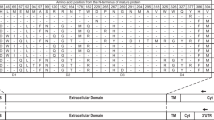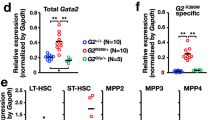Abstract
Members of the human KIR (killer cell immunoglobulin-like receptor) class I major histocompatibility complex receptor gene family contain multiple promoters that determine the variegated expression of KIR on natural killer cells. In order to identify novel genetic alterations associated with decreased KIR expression, a group of donors was characterized for KIR gene content, transcripts and protein expression. An individual with a single copy of the KIR2DL1 gene but a very low level of gene expression was identified. The low expression phenotype was associated with a single-nucleotide polymorphism (SNP) that created a binding site for the inhibitory ZEB1 (Zinc finger E-box-binding homeobox 1) transcription factor adjacent to a c-Myc binding site previously implicated in distal promoter activity. Individuals possessing this SNP had a substantial decrease in distal KIR2DL1 transcripts initiating from a novel intermediate promoter located 230 bp upstream of the proximal promoter start site. Surprisingly, there was no decrease in transcription from the KIR2DL1 proximal promoter. Reduced intermediate promoter activity revealed the existence of alternatively spliced KIR2DL1 transcripts containing premature termination codons that initiated from the proximal KIR2DL1 promoter. Altogether, these results indicate that distal transcripts are necessary for KIR2DL1 protein expression and are required for proper processing of sense transcripts from the bidirectional proximal promoter.
This is a preview of subscription content, access via your institution
Access options
Subscribe to this journal
Receive 6 digital issues and online access to articles
$119.00 per year
only $19.83 per issue
Buy this article
- Purchase on Springer Link
- Instant access to full article PDF
Prices may be subject to local taxes which are calculated during checkout







Similar content being viewed by others
References
Trinchieri G . Biology of natural killer cells. Adv Immunol 1989; 47: 187–376.
Lanier LL . NK cell recognition. Annu Rev Immunol 2005; 23: 225–274.
Carrington M, Norman P . The KIR Gene Cluster. National Library of Medicine (US), NCBI: Bethesda, MD, USA, 2001.
Anderson SK, Ortaldo JR, McVicar DW . The ever-expanding Ly49 gene family: repertoire and signaling. Immunol Rev 2001; 181: 79–89.
Parham P . MHC class I molecules and KIRs in human history, health and survival. Nat Rev Immunol 2005; 5: 201–214.
Valiante NM, Uhrberg M, Shilling HG, Lienert-Weidenbach K, Arnett KL, D’Andrea A et al. Functionally and structurally distinct NK cell receptor repertoires in the peripheral blood of two human donors. Immunity 1997; 7: 739–751.
Held W, Kunz B . An allele-specific, stochastic gene expression process controls the expression of multiple Ly49 family genes and generates a diverse, MHC-specific NK cell receptor repertoire. Eur J Immunol. 1998; 28: 2407–2416.
Santourlidis S, Trompeter HI, Weinhold S, Eisermann B, Meyer KL, Wernet P et al. Crucial role of DNA methylation in determination of clonally distributed killer cell Ig-like receptor expression patterns in NK cells. J Immunol 2002; 169: 4253–4261.
Chan HW, Kurago ZB, Stewart CA, Wilson MJ, Martin MP, Mace BE et al. DNA methylation maintains allele-specific KIR gene expression in human natural killer cells. J Exp Med 2003; 197: 245–255.
Vilches C, Gardiner CM, Parham P . Gene structure and promoter variation of expressed and nonexpressed variants of the KIR2DL5 gene. J Immunol 2000; 165: 6416–6421.
Gomez-Lozano N, Trompeter HI, de Pablo R, Estefania E, Uhrberg M, Vilches C . Epigenetic silencing of potentially functional KIR2DL5 alleles: implications for the acquisition of KIR repertoires by NK cells. Eur J Immunol 2007; 37: 1954–1965.
Stulberg MJ, Wright PW, Dang H, Hanson RJ, Miller JS, Anderson SK . Identification of distal KIR promoters and transcripts. Genes Immun 2007; 8: 124–130.
Cichocki F, Hanson RJ, Lenvik T, Pitt M, McCullar V, Li H et al. The transcription factor c-Myc enhances KIR gene transcription through direct binding to an upstream distal promoter element. Blood 2009; 113: 3245–3253.
Cichocki F, Miller JS, Anderson SK . Killer immunoglobulin-like receptor transcriptional regulation: a fascinating dance of multiple promoters. J Innate Immun 2011; 3: 242–248.
Saleh A, Davies GE, Pascal V, Wright PW, Hodge DL, Cho EH et al. Identification of probabilistic transcriptional switches in the Ly49 gene cluster: a eukaryotic mechanism for selective gene activation. Immunity 2004; 21: 55–66.
Tanamachi DM, Moniot DC, Cado D, Liu SD, Hsia JK, Raulet DH . Genomic Ly49A transgenes: basis of variegated Ly49A gene expression and identification of a critical regulatory element. J Immunol 2004; 172: 1074–1082.
Davies GE, Locke SM, Wright PW, Li H, Hanson RJ, Miller JS et al. Identification of bidirectional promoters in the human KIR genes. Genes Immun 2007; 8: 245–253.
Li H, Pascal V, Martin MP, Carrington M, Anderson SK . Genetic control of variegated KIR gene expression: polymorphisms of the bi-directional KIR3DL1 promoter are associated with distinct frequencies of gene expression. PLoS Genet 2008; 4: e1000254.
Cichocki F, Lenvik T, Sharma N, Yun G, Anderson SK, Miller JS . Cutting edge: KIR antisense transcripts are processed into a 28-base PIWI-like RNA in human NK cells. J Immunol 2010; 185: 2009–2012.
Williams TM, Moolten D, Burlein J, Romano J, Bhaerman R, Godillot A et al. Identification of a zinc finger protein that inhibits IL-2 gene expression. Science 1991; 254: 1791–1794.
Remacle JE, Kraft H, Lerchner W, Wuytens G, Collart C, Verschueren K et al. New mode of DNA binding of multi-zinc finger transcription factors: deltaEF1 family members bind with two hands to two target sites. EMBO J 1991; 18: 5073–5084.
Estefanía E, Flores R, Gomez-Lozano N, Aguilar H, Lopez-Botet M, Vilches C . Human KIR2DL5 is an inhibitory receptor expressed on the surface of NK and T lymphocyte subsets. J Immunol 2007; 178: 4402–4410.
Czaja K, Borer AS, Schmied L, Terszowski G, Stern M, Gonzalez A . A comprehensive analysis of the binding of anti-KIR antibodies to activating KIRs. Genes Immun 2014; 15: 33–37.
Stewart CA, Van Bergen J, Trowsdale J . Different and divergent regulation of the KIR2DL4 and KIR3DL1 promoters. J Immunol 2003; 170: 6073–6081.
Radeloff B, Nagler L, Zirra M, Ziegler A, Volz A . Specific amplification of cDNA ends (SPACE): a new tool for the analysis of rare transcripts and its application for the promoter analysis of killer cell receptor genes. DNA Seq 2005; 16: 44–52.
Pascal V, Stulberg MJ, Anderson SK . Regulation of class I major histocompatibility complex receptor expression in natural killer cells: one promoter is not enough!. Immunol Rev 2006; 214: 9–21.
Fischer JC, Ottinger H, Ferencik S, Sribar M, Punzel M, Beelen DW et al. Relevance of C1 and C2 epitopes for hemopoietic stem cell transplantation: role for sequential acquisition of HLA-C-specific inhibitory killer Ig-like receptor. J Immunol 2007; 178: 3918–3923.
van Bergen J, Stewart CA, van den Elsen PJ, Trowsdale J . Structural and functional differences between the promoters of independently expressed killer cell Ig-like receptors. Eur J Immunol 2005; 35: 2191–2199.
Martin MP, Carrington M . KIR locus polymorphisms: genotyping and disease association analysis. Methods Mol Biol 2008; 415: 49–64.
Cooley S, Xiao F, Pitt M, Gleason M, McCullar V, Bergemann TL et al. A subpopulation of human peripheral blood NK cells that lacks inhibitory receptors for self-MHC is developmentally immature. Blood 2007; 110: 578–586.
Acknowledgements
This project has been funded in whole or in part with federal funds from the National Cancer Institute (NCI), NIH, under contract HHSN261200800001E and NCI grant P01 111412 (to JSM and SKA). This research was supported in part by the Intramural Research Program of the NIH, NCI, Center for Cancer Research. The content of this publication does not necessarily reflect the views or policies of the Department of Health and Human Services, nor does mention of trade names, commercial products or organizations imply endorsement by the US Government.
Author information
Authors and Affiliations
Corresponding author
Ethics declarations
Competing interests
The authors declare no conflict of interest.
Rights and permissions
About this article
Cite this article
Wright, P., Li, H., Huehn, A. et al. Characterization of a weakly expressed KIR2DL1 variant reveals a novel upstream promoter that controls KIR expression. Genes Immun 15, 440–448 (2014). https://doi.org/10.1038/gene.2014.34
Received:
Revised:
Accepted:
Published:
Issue Date:
DOI: https://doi.org/10.1038/gene.2014.34
This article is cited by
-
The KIR2DL1 intermediate upstream element participates in gene activation
Immunogenetics (2023)
-
Characterization of KIR intermediate promoters reveals four promoter types associated with distinct expression patterns of KIR subtypes
Genes & Immunity (2016)
-
2DL1, 2DL2 and 2DL3 all contribute to KIR phenotype variability on human NK cells
Genes & Immunity (2015)
-
Probabilistic Bidirectional Promoter Switches: Noncoding RNA Takes Control
Molecular Therapy - Nucleic Acids (2014)



